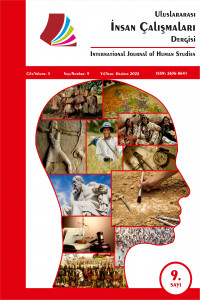Araştırma Makalesi
Yıl 2022,
Cilt: 5 Sayı: 9, 55 - 63, 30.06.2022
Öz
Kazuo Ishiguro’s seventh novel The Buried Giant (2015) investigates the concept of memory in a fantastical tale which is set in the early medieval history of the post-Roman period. In a pattern of quest, the main characters embark on a journey to accomplish their mission. As for Axl and Beatrice, an elderly couple, it is to find their son and recall their lost memories. For Wistan, a Saxon warrior, it is to terminate the she-dragon named Querig whose magical breath causes a mist of forgetfulness across the land. In a narration where individual and collective memory prove to be interconnected, the writer contemplates on loss, regret, forgetting and remembering. While the mutual dependency of the individual and collective memories are presented throughout the text, the nature of traumatic experiences and mourning process is put under the limelight. The end of the novel puts an emphasis on the question of whether remembering is a blessing or a curse for both the individual and the community or nation. In this article, therefore, brief biographical information about Kazuo Ishiguro will be first given and afterwards the interconnected of individual and collective memory will be explored with the help of scholars such as Maurice Halbwachs, Cathy Caruth and Anne Whitehead. The opportunities offered by the individual and collective recollection, as well as the dilemmas and constraits it causes will be exemplified through the main characters in the novel.
Kaynakça
- Borowska-Szerszun, Sylwia (2016). The giants beneath: cultural memory and literature in Kazuo Ishiguro’s The Buried Giant. Crossroads, 15/4, 30-41. Doi: 10.15290/cr.2016.15.4.03
- Caruth, Cathy (1996). Experience, Trauma, Narrative, and History. Baltimore and London: The John Hopkins University Press.
- Chattopadhyay, Piya (2015). Interview with Kazuo Ishiguro. The Agenda. https://www.youtube. Com/watch?v=QizlLvkdgnk. 12 Nov. 2016.
- Erll, Astrid (2011). Memory in Culture. Trans. Sara B. Young. New York: Palgrave Macmillan.
- Halbwachs, Maurice (1980). The Collective Memory. New York: Harper Colophon Books.
- Ishiguro, Kazuo (2015). The Buried Giant. New York: Alfred A. Knopf.
- Lorek-Jezinska, Edyta (2016). Testimonies of absence: trauma and forgetting in The Buried Giant By Kazuo Ishiguro. Crossroads, 15/4, 42-51. Doi: 10.15290/cr.2016.15.4.04
- Ricoeur, Paul (2006). Memory, History, Forgetting. Chicago: University of Chicago Press.
- Teo, Yugin (2014). Kazuo Ishiguro and Memory. New York: Palgrave Macmillan.
- Valanciunas, Deimentas (2018). Forgetting or Making to Forget: Memory, Trauma and Identity in Kazuo Ishiguro’s The Buried Giant. History, Memory and Nostalgia in Literature and Culture. 213-227. Ed. Regina Rudaityte. Newcastle: Cambridge Scholars Publishing.
- Whitehead, Anne (2009). Memory. New York: Routledge.
Yıl 2022,
Cilt: 5 Sayı: 9, 55 - 63, 30.06.2022
Öz
Kazuo Ishiguro’nun yedinci romanı Gömülü Dev (2015), Roma sonrası dönemin erken ortaçağ tarihinde fantastik bir hikâyede bellek kavramını ele almaktadır. Bir yolculuk modeli içinde gerçekleşen bu anlatıda ana karakterler görevlerini yerine getirmek için yola çıkarlar. Yaşlı bir çift olan Axl ve Beatrice için bu görev oğullarını bulmak ve kayıp anılarını hatırlamaktır. Bir Sakson savaşçısı olan Wiston için ise bu görev büyülü nefesi tüm ülkede bir unutkanlık sisine neden olan Querig ismindeki dişi ejderhayı yok etmektir. Bireysel ve toplumsal hafızanın birbirine bağlı olduğunun gösterildiği bir anlatıda yazar yitiriş, pişmanlık, unutuş ve hatırlayış üzerine düşünür. Metin boyunca bireysel ve kolektif anıların birbirine bağlılığı sunulurken, travmatik deneyimlerin ve yas sürecinin doğası da odak noktası haline getirilir. Romanın sonu, hatırlamanın hem birey hem de toplum veya ulus için bir nimet mi yoksa bir lanet mi olduğu sorusuna vurgu yapar. Bu nedenle bu makalede öncelikle Kazuo Ishiguro hakkında kısa biyografik bilgi verilecek ve ardından Maurice Halbwachs, Cathy Caruth ve Anne Whitehead gibi uzmanların yardımıyla bireysel ve kolektif hafızanın birbirine bağlılığı roman üzerinden örneklerle araştırılacaktır. Bireysel ve kolektif hatırlamanın sunduğu fırsatlar ve aynı zamanda neden olduğu açmazlar ve kısıtlamalar romandaki ana karakterler üzerinden örneklendirilecektir.
Kaynakça
- Borowska-Szerszun, Sylwia (2016). The giants beneath: cultural memory and literature in Kazuo Ishiguro’s The Buried Giant. Crossroads, 15/4, 30-41. Doi: 10.15290/cr.2016.15.4.03
- Caruth, Cathy (1996). Experience, Trauma, Narrative, and History. Baltimore and London: The John Hopkins University Press.
- Chattopadhyay, Piya (2015). Interview with Kazuo Ishiguro. The Agenda. https://www.youtube. Com/watch?v=QizlLvkdgnk. 12 Nov. 2016.
- Erll, Astrid (2011). Memory in Culture. Trans. Sara B. Young. New York: Palgrave Macmillan.
- Halbwachs, Maurice (1980). The Collective Memory. New York: Harper Colophon Books.
- Ishiguro, Kazuo (2015). The Buried Giant. New York: Alfred A. Knopf.
- Lorek-Jezinska, Edyta (2016). Testimonies of absence: trauma and forgetting in The Buried Giant By Kazuo Ishiguro. Crossroads, 15/4, 42-51. Doi: 10.15290/cr.2016.15.4.04
- Ricoeur, Paul (2006). Memory, History, Forgetting. Chicago: University of Chicago Press.
- Teo, Yugin (2014). Kazuo Ishiguro and Memory. New York: Palgrave Macmillan.
- Valanciunas, Deimentas (2018). Forgetting or Making to Forget: Memory, Trauma and Identity in Kazuo Ishiguro’s The Buried Giant. History, Memory and Nostalgia in Literature and Culture. 213-227. Ed. Regina Rudaityte. Newcastle: Cambridge Scholars Publishing.
- Whitehead, Anne (2009). Memory. New York: Routledge.
Toplam 11 adet kaynakça vardır.
Ayrıntılar
| Birincil Dil | İngilizce |
|---|---|
| Konular | Sanat ve Edebiyat |
| Bölüm | Makaleler |
| Yazarlar | |
| Yayımlanma Tarihi | 30 Haziran 2022 |
| Gönderilme Tarihi | 25 Eylül 2021 |
| Kabul Tarihi | 9 Haziran 2022 |
| Yayımlandığı Sayı | Yıl 2022 Cilt: 5 Sayı: 9 |



